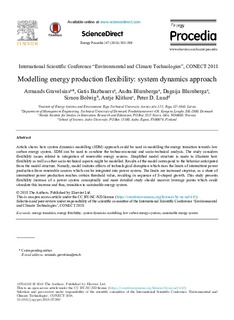| dc.contributor.author | Gravelsinš, Armands | |
| dc.contributor.author | Bazbauers, Gatis | |
| dc.contributor.author | Blumberga, Andra | |
| dc.contributor.author | Blumberga, Dagnija | |
| dc.contributor.author | Bolwig, Simon | |
| dc.contributor.author | Klitkou, Antje | |
| dc.contributor.author | Lund, Peter D. | |
| dc.date.accessioned | 2019-03-15T14:49:05Z | |
| dc.date.available | 2019-03-15T14:49:05Z | |
| dc.date.created | 2018-12-05T09:13:35Z | |
| dc.date.issued | 2018-09-08 | |
| dc.identifier.citation | Gravelsinš, A., Bazbauers, G., Blumberga, A., Blumberga, D., Bolwig, S., Klitkou, A. & Lund, P. D. (2018). Modelling energy production flexibility: system dynamics approach. Energy Procedia, 147, 503-509. | nb_NO |
| dc.identifier.issn | 1876-6102 | |
| dc.identifier.uri | http://hdl.handle.net/11250/2590319 | |
| dc.description.abstract | Article shows how system dynamics modelling (SDM) approach could be used in modelling the energy transition towards low carbon energy system. SDM can be used to combine the techno-economic and socio-technical analysis. The study considers flexibility issues related to integration of renewable energy sources. Simplified model structure is made to illustrate how flexibility as well as other socio-technical aspects might be modelled. Results of the model correspond to the behavior anticipated from the model structure. Namely, model imitates effects of technological disruption which rises the limits of intermittent power production from renewable sources which can be integrated into power system. The limits are increased stepwise, as a share of intermittent power production reaches certain threshold value, resulting in sequence of S-shaped growth. This study presents flexibility increase of a power system conceptually and more detailed study should uncover leverage points which could stimulate this increase and thus, transition to sustainable energy system. | nb_NO |
| dc.language.iso | eng | nb_NO |
| dc.publisher | Elsevier | nb_NO |
| dc.rights | Attribution-NonCommercial-NoDerivatives 4.0 Internasjonal | * |
| dc.rights.uri | http://creativecommons.org/licenses/by-nc-nd/4.0/deed.no | * |
| dc.subject | Bærekraftige energisystemer | nb_NO |
| dc.subject | Sustainable energy systems | nb_NO |
| dc.subject | Modellering | nb_NO |
| dc.subject | Modelling | nb_NO |
| dc.subject | Energy transition | nb_NO |
| dc.subject | Energy flexibility | nb_NO |
| dc.subject | System dynamics modelling | nb_NO |
| dc.subject | Low carbon energy systems | nb_NO |
| dc.subject | Sustainable energy system | nb_NO |
| dc.title | Modelling energy production flexibility: system dynamics approach | nb_NO |
| dc.type | Journal article | nb_NO |
| dc.type | Peer reviewed | nb_NO |
| dc.description.version | publishedVersion | nb_NO |
| dc.subject.nsi | VDP::Samfunnsvitenskap: 200 | nb_NO |
| dc.subject.nsi | VDP::Social sciences: 200 | nb_NO |
| dc.source.pagenumber | 503-509 | nb_NO |
| dc.source.volume | 147 | nb_NO |
| dc.source.journal | Energy Procedia | nb_NO |
| dc.identifier.doi | 10.1016/j.egypro.2018.07.060 | |
| dc.identifier.cristin | 1639275 | |
| dc.relation.project | Nordisk Energiforskning: 76084 | nb_NO |
| cristin.unitcode | 7463,0,0,0 | |
| cristin.unitname | NIFU Nordisk institutt for studier av innovasjon, forskning og utdanning | |
| cristin.ispublished | true | |
| cristin.fulltext | original | |
| cristin.qualitycode | 0 | |

